-
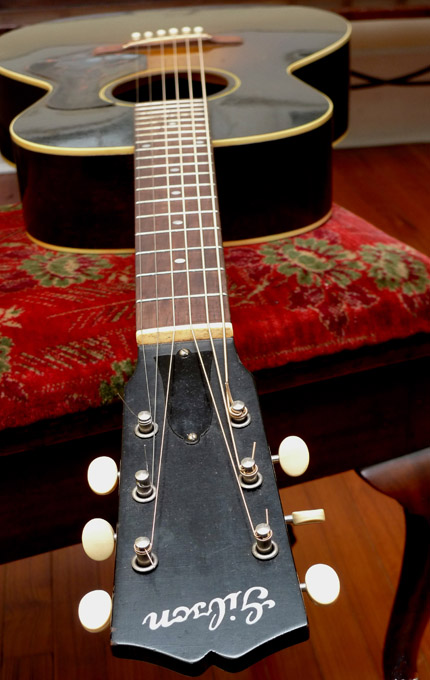 Crack-free, and 100% original, down to the bridge pins, and the original Geib case. Just getting a neck set to make it play perfectly.
Crack-free, and 100% original, down to the bridge pins, and the original Geib case. Just getting a neck set to make it play perfectly. -
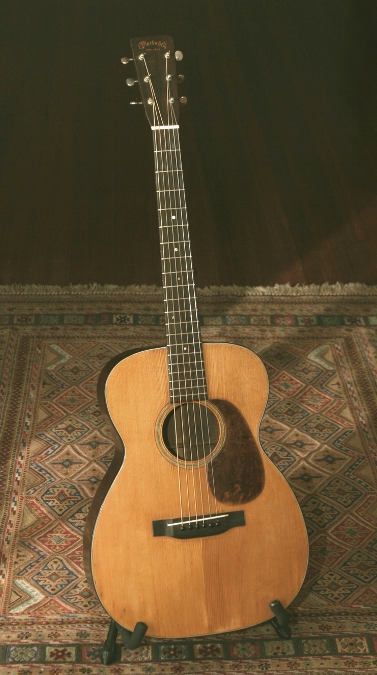 Probably the best year ever for 14-fret 00-18s. In the Golden Age of 14-fret Martins from the early 30's until the late 30's, only in 1936 did Martin use Brazilian rosewood (as opposed to ebony) for the fretboard and bridges of 18's, so its tone is considered by many to be the best in the 14 fret, 1-3/4 inch nut era. The guitar is crack-free on the top and back. Just one repaired crack on the treble side.The repair is well done and almost impossible to see from the outside (older repair has muslin cloth on inside-luthiers agree that these older cloth patches inside a vintage Martin should be left in place). Original tuners. Original bridge plate. Original nut. Replaced T-frets by us. Replacement bridge-very dark Brazilian rosewood bridge made to original specs in our shop, and ivory saddle. The neck has that wonderful mid-thirties slightly fatter profile. Neck set by us. And the tone is the best example of a Golden Era 00-18 you'll find anywhere. Light overspray (no refinishing) on back and sides (not top, neck or head).
Probably the best year ever for 14-fret 00-18s. In the Golden Age of 14-fret Martins from the early 30's until the late 30's, only in 1936 did Martin use Brazilian rosewood (as opposed to ebony) for the fretboard and bridges of 18's, so its tone is considered by many to be the best in the 14 fret, 1-3/4 inch nut era. The guitar is crack-free on the top and back. Just one repaired crack on the treble side.The repair is well done and almost impossible to see from the outside (older repair has muslin cloth on inside-luthiers agree that these older cloth patches inside a vintage Martin should be left in place). Original tuners. Original bridge plate. Original nut. Replaced T-frets by us. Replacement bridge-very dark Brazilian rosewood bridge made to original specs in our shop, and ivory saddle. The neck has that wonderful mid-thirties slightly fatter profile. Neck set by us. And the tone is the best example of a Golden Era 00-18 you'll find anywhere. Light overspray (no refinishing) on back and sides (not top, neck or head). -
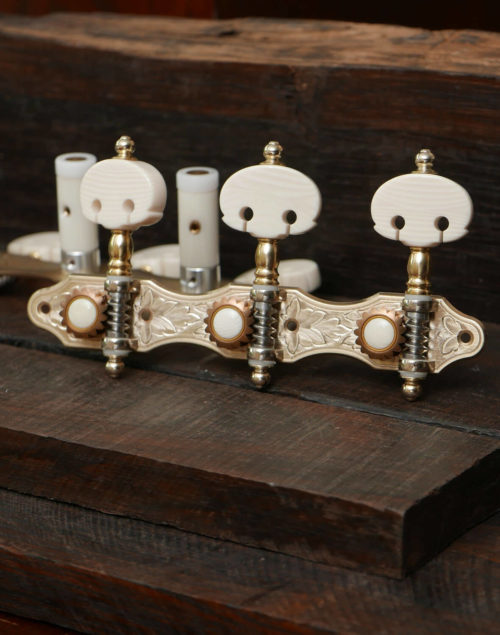 Alessi, Hauser style machine head tuners. More rare, deep silver plating. Hand made in Italy. Engraved with high detail. These are new, old stock. Made circa 2009, they have never been used or mounted on a guitar, and they come with the original mounting screws, and in their original wood presentation case. Synthetic ivory kidney shaped buttons (rare style). 35mm on center. Perfect, unused condition. Price: $895.
Alessi, Hauser style machine head tuners. More rare, deep silver plating. Hand made in Italy. Engraved with high detail. These are new, old stock. Made circa 2009, they have never been used or mounted on a guitar, and they come with the original mounting screws, and in their original wood presentation case. Synthetic ivory kidney shaped buttons (rare style). 35mm on center. Perfect, unused condition. Price: $895. -
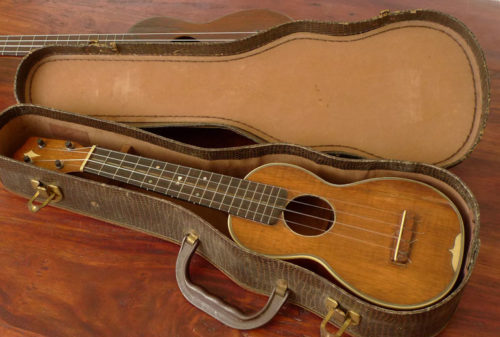 One of the first Martin 3K Ukeleles ever made. This is possibly a prototype, one of the first, all hand-made Martin 3K Ukeleles, made probably before the official introduction of the model by Martin in 1919-1920. It has many signs that it was the one of the first ones:
One of the first Martin 3K Ukeleles ever made. This is possibly a prototype, one of the first, all hand-made Martin 3K Ukeleles, made probably before the official introduction of the model by Martin in 1919-1920. It has many signs that it was the one of the first ones:- Ebony fretboard is hand-cut
- Fretboard inlays are hand-cut
- There is an "A" on the back of headstock... could be a marking by the Martin craftsmen in-house to indicate a prototype.
- Several cracks on back (repaired)
- Two cracks on top (repaired)
- There is one missing brace, a back brace, inside. Since ukeleles are so small, that brace has no real structural importance, so we decided not to replace it
- The sound hole was at some point enlarged slightly, either at the factory, or later. Probably later– so we’ll call it the Tony Rice model… this modification does add loudness
- The finish is all original.
- Original striped nut
- 3 lines inlaid down center of fingerboard.
- 7 ply side binding
- Celluloid ornament on top, behind bridge (known as the "parend").
- Small pearl paired-diamond inlays at fret 5, 7, 9– hand-cut. With the “bowtie” at the 7th fret
- Kite-shaped celluloid ornament on front of headstock
- Original friction pegs
- Ebony fretboard
- C.F. Martin & Co. stamp on back of headstock.
-
 A chance to own a great sounding, great playing Brazilian Rosewood D-28, at a fraction of the cost of an all-original example. This D-28 has had some work, and a few issues, but it’s all repaired and ready to play. And the tone is incredible– tone you won’t find in any other mid-50’s D-28. This guitar, has just been gone over head to end pin, repaired, restored, and set up, by two of the top luthiers/repairmen in Texas, and it’s good to go for decades. The bridge is perfect. Saddle is perfect height. Action is great– low but no buzzing. It won’t need a thing. Ready to play. The tone: the scalloped braces add roundness and clarity to the basses (A and D string in particular) and a bit more “ring” to the trebles. Don’t try this at home– a scalloped braced mid 50’s D-28, but the result, set up by two of this country’s top luthiers, is a great sounding brazilian Martin dread, whose tone you won’t find in any Martin north of 1944– certainly not at this price. Here’s the report:
A chance to own a great sounding, great playing Brazilian Rosewood D-28, at a fraction of the cost of an all-original example. This D-28 has had some work, and a few issues, but it’s all repaired and ready to play. And the tone is incredible– tone you won’t find in any other mid-50’s D-28. This guitar, has just been gone over head to end pin, repaired, restored, and set up, by two of the top luthiers/repairmen in Texas, and it’s good to go for decades. The bridge is perfect. Saddle is perfect height. Action is great– low but no buzzing. It won’t need a thing. Ready to play. The tone: the scalloped braces add roundness and clarity to the basses (A and D string in particular) and a bit more “ring” to the trebles. Don’t try this at home– a scalloped braced mid 50’s D-28, but the result, set up by two of this country’s top luthiers, is a great sounding brazilian Martin dread, whose tone you won’t find in any Martin north of 1944– certainly not at this price. Here’s the report:- sometime decades ago, the top braces were scalloped
- probably as a result of a minor impact at the end pin (guitar dropped), there were cracks in the sides, and a slight crack to the neck block. So a previous luthier, long before we acquired the guitar, put in 4 small wood dowels, through the sides–near the heel, into the block (see photos). All is stable. Not the prettiest solution, but it works well.
- Small crack in heel, repaired and stable
- Original finish, on Sitka Spruce top; Oversprayed back, sides, and neck (but back of neck finish has worn, giving a natural, comfortable feel)
- A bit of damage to one corner of the headstock. But there are no cracks in headstock.
- Pickup jack installed years ago at end pin; no pickup inside; Also, an old pickup jack on bass side of guitar, filled.
- Some pickwear loss, bottom edge of soundhole
- Top of guitar has no serious cracks. No "B string" pickguard crack. Tiny crack along the treble edge of the pick guard. A couple more finish type of cracks that do not go through the wood to inside.
- Several side cracks, all addressed.
- Back of guitar has no cracks through the wood. A couple of finish cracks.
- neck set, by John Allison
- Refret, by John Allison
- New, 100% period correct, ebony bridge, made and installed by John Allison. Bridge is made to the exact specs, footprint, etc, of an original 1956 Martin bridge. A small area of finish around an older oversized bridge was addressed by John (you can see this in the photos).
- New, period correct Maple bridge plate, installed by Tony Nobles
- Old pickup jack on bass side of guitar, filled by Tony Nobles.
- The wonderful, original gold-plated Kluson waffle-back tuners, are original, and work perfectly.
- Original pickguard
- Original Martin logo on headstock
-
 Another Gibson L-00, with great tone and volume, and all original finish. The top and sides are completely crack-free, and there are several small dryness cracks on the back. The bridge is original, and has never been off the guitar. We just set the neck, and installed a new bone saddle. The bridge plate is original and in perfect condition. Original firestripe pickguard. Original nut. Original frets.
Another Gibson L-00, with great tone and volume, and all original finish. The top and sides are completely crack-free, and there are several small dryness cracks on the back. The bridge is original, and has never been off the guitar. We just set the neck, and installed a new bone saddle. The bridge plate is original and in perfect condition. Original firestripe pickguard. Original nut. Original frets. -
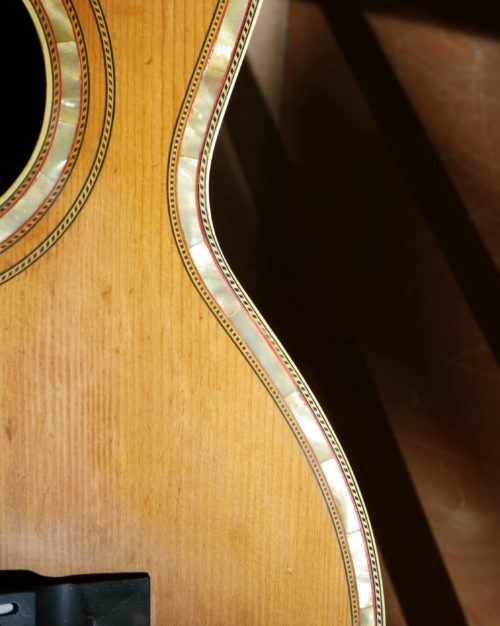 Circa 1912 Mother of Pearl Inlaid Guitar The guitar is extensively inlayed with mother of pearl . The guitar was restored in 2001, work that included converting the instrument to X-bracing, reproduction ebony bridge, reproduction small maple bridge plate. It’s signed inside by the restorer, “B. Lehmann 2001” (Bernie Lehmann, well known luthier in New York.) The guitar has no stamps or labels, but it was probably made by George Bauer – because of many stylistic similarities. The guitar is set up and ready to play. As many guitars of this era, the tone is tilted toward very bright, glassy, brazilian rosewood trebles, not fuller bass. Solid Spruce top Solid Brazilian Rosewood back and sides MOP inlays, fretboard, rosette, and bindings X-braced Original tuners Width at lower bout: 13 1/2 inches Scale Length: 24 7/8 inches Nut Width: 1 ¾ inches V shaped neck .... no longer available....
Circa 1912 Mother of Pearl Inlaid Guitar The guitar is extensively inlayed with mother of pearl . The guitar was restored in 2001, work that included converting the instrument to X-bracing, reproduction ebony bridge, reproduction small maple bridge plate. It’s signed inside by the restorer, “B. Lehmann 2001” (Bernie Lehmann, well known luthier in New York.) The guitar has no stamps or labels, but it was probably made by George Bauer – because of many stylistic similarities. The guitar is set up and ready to play. As many guitars of this era, the tone is tilted toward very bright, glassy, brazilian rosewood trebles, not fuller bass. Solid Spruce top Solid Brazilian Rosewood back and sides MOP inlays, fretboard, rosette, and bindings X-braced Original tuners Width at lower bout: 13 1/2 inches Scale Length: 24 7/8 inches Nut Width: 1 ¾ inches V shaped neck .... no longer available.... -
Out of stock
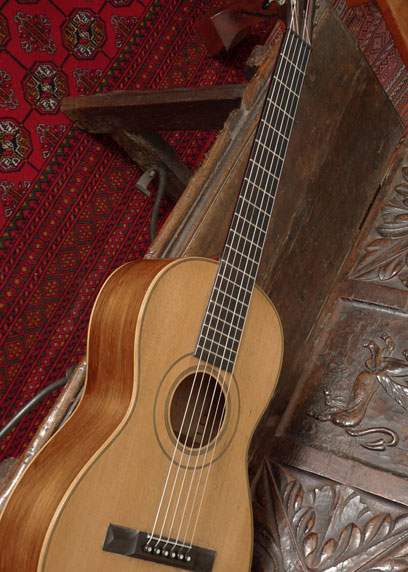 Circa 1860 guitar, style 3 built by well known luthier James Ashborn of Wolcottville, CT, for William Hall & Son music store. Brazilian rosewood back and sides; Adirondack top; maple binding. Rare Brazilian rosewood veneered neck. 100% original, including all original finish, and down to original nut, original bridge (and saddle) that has never been off the guitar. From an article in Vintage Guitar magazine: "Ashborn's design for the guitar was quite innovative for the early 19th century. Instead of making guitars fashioned after the typical parlor-style guitars, he made them in the Spanish style, by taking interior bracing cues from the Spanish while retaining the body of the English guitars. This included a fan brace pattern rather than the more common ladder pattern Ashborn guitars have a very complex dovetail V joint for attaching the head to the neck. The headstock was cut in roughly five steps, using some kind of tracing router, as suggested by the chatter marks on the inside ears of the pegbox. In addition to the complex head design, Ashborn made his own tuning machines in-house. They're made of brass, very much like contemporary machines, with worm gears, cog gears, and rollers. … Ashborn's shop was extremely advanced for its time, having a great deal of know-how and technology. Ashborn understood the need to have the technology as well as the skill, but more importantly he discovered a new way of making high-quality instruments that were affordable. He was able to create a factory environment where workers did what they were good at and, with practice, became very fast and consistent. With a new level of consistency in mass production, he created the path followed by other companies such as Martin, Gibson, and Taylor. Using designs ahead of his time, he was able to bring the sound and change to people who otherwise never would have been able to acquire an instrument of this quality."
Circa 1860 guitar, style 3 built by well known luthier James Ashborn of Wolcottville, CT, for William Hall & Son music store. Brazilian rosewood back and sides; Adirondack top; maple binding. Rare Brazilian rosewood veneered neck. 100% original, including all original finish, and down to original nut, original bridge (and saddle) that has never been off the guitar. From an article in Vintage Guitar magazine: "Ashborn's design for the guitar was quite innovative for the early 19th century. Instead of making guitars fashioned after the typical parlor-style guitars, he made them in the Spanish style, by taking interior bracing cues from the Spanish while retaining the body of the English guitars. This included a fan brace pattern rather than the more common ladder pattern Ashborn guitars have a very complex dovetail V joint for attaching the head to the neck. The headstock was cut in roughly five steps, using some kind of tracing router, as suggested by the chatter marks on the inside ears of the pegbox. In addition to the complex head design, Ashborn made his own tuning machines in-house. They're made of brass, very much like contemporary machines, with worm gears, cog gears, and rollers. … Ashborn's shop was extremely advanced for its time, having a great deal of know-how and technology. Ashborn understood the need to have the technology as well as the skill, but more importantly he discovered a new way of making high-quality instruments that were affordable. He was able to create a factory environment where workers did what they were good at and, with practice, became very fast and consistent. With a new level of consistency in mass production, he created the path followed by other companies such as Martin, Gibson, and Taylor. Using designs ahead of his time, he was able to bring the sound and change to people who otherwise never would have been able to acquire an instrument of this quality." -
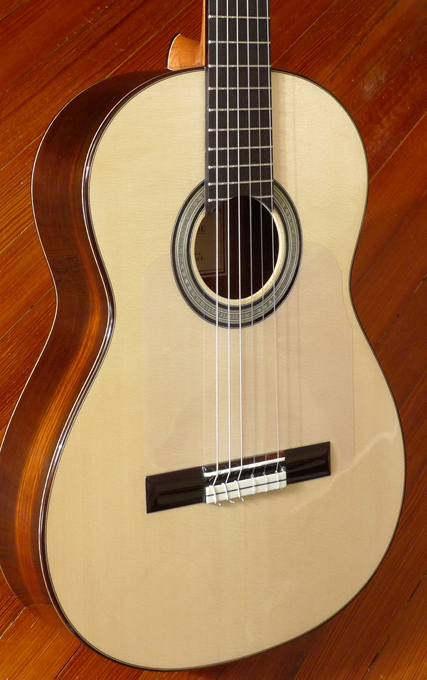 This new, custom made Lester Devoe Flamenco Negra is amasterpiece, from one of the world’s top luthiers. Lester Devoe needs nointroduction to the world’s great Flamenco players. The late, legendary Sabicasplayed a Devoe– and converted some of the great Flamenco players in Spain tothe fold. Paco De Lucia, and Vicente Amigo, among others, play Devoe Flamencoguitars. Paco De Lucia began playing a Devoe Negra guitar years ago– and thereare many Paco De Lucia recordings and feature films where Paco plays a DevoeFlamenco guitar.) This is the second custom guitar, that Lester has made for uswith select, old growth, quartersawn AAAAA Brazilian rosewood. Signed by LesterDevoe, 2012 (March).
This new, custom made Lester Devoe Flamenco Negra is amasterpiece, from one of the world’s top luthiers. Lester Devoe needs nointroduction to the world’s great Flamenco players. The late, legendary Sabicasplayed a Devoe– and converted some of the great Flamenco players in Spain tothe fold. Paco De Lucia, and Vicente Amigo, among others, play Devoe Flamencoguitars. Paco De Lucia began playing a Devoe Negra guitar years ago– and thereare many Paco De Lucia recordings and feature films where Paco plays a DevoeFlamenco guitar.) This is the second custom guitar, that Lester has made for uswith select, old growth, quartersawn AAAAA Brazilian rosewood. Signed by LesterDevoe, 2012 (March).- 650mm scale length
- Nut: 52mm
- Neck width at nut: 52mm
- 80 year old Brazilian Rosewood (pre-CITES) back and sides (Quartersawn).
- European spruce top
- Cedar neck
- Brazilian Rosewood headstock overlay, and bridge
- Brazilian Rosewood body binding, top and back
- Ebony fingerboard
- Sloane tuners
- Nitrocellulose lacquer finish
-
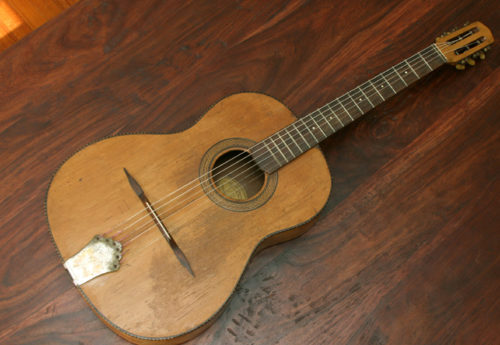 When Martin entered into its “Golden Age” for the flat top guitar, the jazz guitar was evolving on a parallel and equally important track. And in Europe, especially France, they had their own ideas about guitar making, and produced some brilliant guitars in this era–including of course the wonderful Selmer gypsy jazz guitar. The brothers Gerome were among the best luthiers in Mirecourt, France, a city famous in Europe for producing the finest gypsy and jazz guitars, in the 20s, 30s, and 40s. This all original, gypsy style guitar has maple back and sides, to give that high, twangy tone, just what you want in a django-style guitar. This one has loud piercing trebles–the treble strings are louder and more piercing than any guitar of any kind I have ever heard. Only maple produces that loud sharp treble. The volume of this instrument is striking, and there is almost a “reverb”, resonant quality to the tone. Solid spruce top. Black & white checkerboard marquetry binding on top, and rosette. It has a very thick rosewood fingerboard (over 4/10 inches/10.5mm thick!) Maple neck. Nut just shy of 1 7/8 inch. Wonderful bakelite buttons on the tuners. And it would not be a genuine gypsy jazz classic, if it did not have the hallmarks of this style: the original “floating bridge”–not an “adjustable brigde” for height, but a floating rosewood bridge that is not glued to the top, but held on by string tension (the “wings” of the bridge are glued to the top in this configuration). (You can of course change the intonation with this set-up.) The other feature that is a must, is the “zero fret”, i.e. there is a fret (the “zero” fret) right in front of the nut. 14-5/8 inch wide at lower bout. All original finish. A couple of small cracks on top. Top center seam repair. Original T-frets show wear, but still work fine. No buzzing. Action is good. Takes loop-end strings (available from many sources–Savarez Argentine strings are great on this instrument).
When Martin entered into its “Golden Age” for the flat top guitar, the jazz guitar was evolving on a parallel and equally important track. And in Europe, especially France, they had their own ideas about guitar making, and produced some brilliant guitars in this era–including of course the wonderful Selmer gypsy jazz guitar. The brothers Gerome were among the best luthiers in Mirecourt, France, a city famous in Europe for producing the finest gypsy and jazz guitars, in the 20s, 30s, and 40s. This all original, gypsy style guitar has maple back and sides, to give that high, twangy tone, just what you want in a django-style guitar. This one has loud piercing trebles–the treble strings are louder and more piercing than any guitar of any kind I have ever heard. Only maple produces that loud sharp treble. The volume of this instrument is striking, and there is almost a “reverb”, resonant quality to the tone. Solid spruce top. Black & white checkerboard marquetry binding on top, and rosette. It has a very thick rosewood fingerboard (over 4/10 inches/10.5mm thick!) Maple neck. Nut just shy of 1 7/8 inch. Wonderful bakelite buttons on the tuners. And it would not be a genuine gypsy jazz classic, if it did not have the hallmarks of this style: the original “floating bridge”–not an “adjustable brigde” for height, but a floating rosewood bridge that is not glued to the top, but held on by string tension (the “wings” of the bridge are glued to the top in this configuration). (You can of course change the intonation with this set-up.) The other feature that is a must, is the “zero fret”, i.e. there is a fret (the “zero” fret) right in front of the nut. 14-5/8 inch wide at lower bout. All original finish. A couple of small cracks on top. Top center seam repair. Original T-frets show wear, but still work fine. No buzzing. Action is good. Takes loop-end strings (available from many sources–Savarez Argentine strings are great on this instrument). -
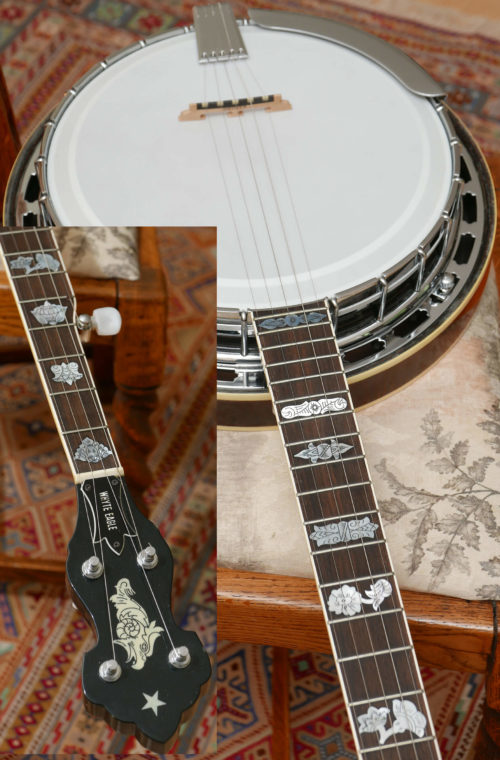 Early 1970s, but in remarkably original condition. And this instrument is from the first, early production– so it has the maple 3-ply rim. This should not be compared to later production Whyte Eagles– this is a very rare early one with unique features, and great tone. This banjo design is based on: • neck/head/inlays: based on the high end Fairbanks Whyte Ladye of the early 20th century– one of the most beautiful designs in banjo history • the pot assembly is modeled closely on the Gibson TB3, archtop of the 1930's. In fact it's a remarkable recreation of that design (and sound) – a more faithful recreation that many Gibson post-war versions. Bluegrass banjo players seek out the 70’s Alvarez Whyte Eagles, known for their tone and craftsmanship. It was a pretty short window of only about five years, when these banjos were made with this kind of craftsmanship. They blow away most any banjo made and marketed (from any country) in the 60s, 70s and 80s– and they show no logos on headstock– just beautiful mother of pearl. It’s the No. 4310 “Whyte Eagle”. Based on late 1920’s Vega Griffin (Tubaphone #9) style inlays, with engraved, carved heel. Sunburst finish maple banjo, Gibson-style 2 piece flange, full height 20 hole archtop tone ring, dual coordinator rods, flamed maple resonator, maple neck, chrome finish. Neck is butterfly with ebony strip on back of neck, down the center. It’s extremely rare to find a Whyte Eagle from this very early period (serial number 1672), when they first came out and the company bent over backwards to produce an instrument with zero compromise, from the inlays to the maple rim. The early features that are not on the later 70's Whyte Eagles, are– in addition to the 3-ply maple rim (not the 10-ply rim of almost all other Whyte Eagles)– the smaller star on the front of headstock (later models had a larger star), no “Alvarez” logo just the eagle inlay, and a darker sunburst on the resonator and also on the back of the neck. Flamed maple resonator (sunburst back, with a touch of milkiness to the original finish) Maple butterfly neck Hand-carved heel Mother of pearl inlays Original tuners Grover bridge 1 3/16 nut Scale: 26 ¼ inches 20 hole archtop tone ring 11 inch head ... no longer available ...
Early 1970s, but in remarkably original condition. And this instrument is from the first, early production– so it has the maple 3-ply rim. This should not be compared to later production Whyte Eagles– this is a very rare early one with unique features, and great tone. This banjo design is based on: • neck/head/inlays: based on the high end Fairbanks Whyte Ladye of the early 20th century– one of the most beautiful designs in banjo history • the pot assembly is modeled closely on the Gibson TB3, archtop of the 1930's. In fact it's a remarkable recreation of that design (and sound) – a more faithful recreation that many Gibson post-war versions. Bluegrass banjo players seek out the 70’s Alvarez Whyte Eagles, known for their tone and craftsmanship. It was a pretty short window of only about five years, when these banjos were made with this kind of craftsmanship. They blow away most any banjo made and marketed (from any country) in the 60s, 70s and 80s– and they show no logos on headstock– just beautiful mother of pearl. It’s the No. 4310 “Whyte Eagle”. Based on late 1920’s Vega Griffin (Tubaphone #9) style inlays, with engraved, carved heel. Sunburst finish maple banjo, Gibson-style 2 piece flange, full height 20 hole archtop tone ring, dual coordinator rods, flamed maple resonator, maple neck, chrome finish. Neck is butterfly with ebony strip on back of neck, down the center. It’s extremely rare to find a Whyte Eagle from this very early period (serial number 1672), when they first came out and the company bent over backwards to produce an instrument with zero compromise, from the inlays to the maple rim. The early features that are not on the later 70's Whyte Eagles, are– in addition to the 3-ply maple rim (not the 10-ply rim of almost all other Whyte Eagles)– the smaller star on the front of headstock (later models had a larger star), no “Alvarez” logo just the eagle inlay, and a darker sunburst on the resonator and also on the back of the neck. Flamed maple resonator (sunburst back, with a touch of milkiness to the original finish) Maple butterfly neck Hand-carved heel Mother of pearl inlays Original tuners Grover bridge 1 3/16 nut Scale: 26 ¼ inches 20 hole archtop tone ring 11 inch head ... no longer available ... -
Out of stock
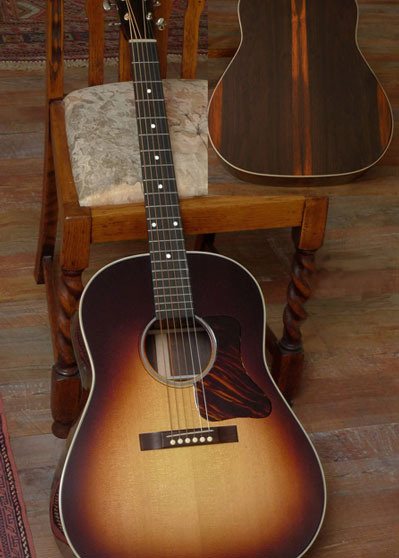 Another masterpiece from Charlottesville, Virginia-based Rockbridge Guitars. The slope shouldered dreadnought is faithful to the great Gibson J-35 of the late 1930’s, plus more: old-growth Brazilian Rosewood, with remarkable landscaping. Big big tone, volume, projection. Great sustain, ringing trebles, and yes most importantly string separation. Ebony fretboard. In a custom Cedar Creek case. Read the full description below. If you're interested in this guitar, please call 512.922.8596 or contact us here. ... no longer available ...
Another masterpiece from Charlottesville, Virginia-based Rockbridge Guitars. The slope shouldered dreadnought is faithful to the great Gibson J-35 of the late 1930’s, plus more: old-growth Brazilian Rosewood, with remarkable landscaping. Big big tone, volume, projection. Great sustain, ringing trebles, and yes most importantly string separation. Ebony fretboard. In a custom Cedar Creek case. Read the full description below. If you're interested in this guitar, please call 512.922.8596 or contact us here. ... no longer available ...